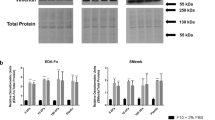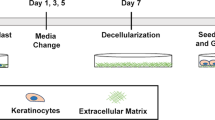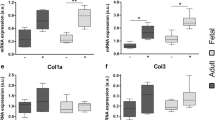Abstract
In this study, we sought to establish a defined experimental system for fibroblast growth similar to that of the living dermis. To this end, we evaluated the growth and biochemical characteristics of fibroblasts cultured with serum-free HFDM-1, a finely tuned synthetic medium for human fibroblast culture. Three culture conditions were used to grow fibroblasts obtained from primary culture: (1) culture with Dulbecco’s modified Eagle medium (DMEM) plus 10 % fetal bovine serum (serum-supplemented DMEM), (2) culture with DMEM (serum-free DMEM), and (3) culture with HFDM-1 (HFDM-1), and fibroblast morphology, growth, collagen type I production, and lipid composition were analyzed. Fibroblasts grown in HFDM-1 maintained cell numbers at nearly 100 % from days 14 to 21 and produced more collagen type I than cells grown in serum-supplemented and serum-free DMEM. Arachidonic acid (20:4) and total polyunsaturated fatty acids were lower in cells grown in serum-free DMEM and HFDM-1 than in serum-supplemented DMEM. These results suggested that HFDM-1 recapitulated growth conditions in the dermis better than traditional, serum-supplemented DMEM. In addition, the controlled chemical composition of HFDM-1 eliminated a potential source of variability in cell culture conditions.





Similar content being viewed by others

References
Balazs L, Okolicany J, Ferrebee M, Tolley B, Tigyi G (2001) Topical application of the phospholipids growth factor lysophosphatidic acid promotes wound healing in vivo. Am J Physiol Regul Integr Comp Physiol 280:R466–R472
Bettger WJ, Boyce ST, Walthall BJ, Ham RG (1981) Rapid clonal growth and serial passage of human diploid fibroblasts in a lipid-enriched synthetic medium supplemented with epidermal growth factor, insulin, and dexamethasone. Proc Natl Acad Sci USA 78:5588–5592
Cardoso CRB, Souza MA, Ferro EAV, Favoreto S, Pena JDO (2004) Influence of topical administration of n-3 and n-6 essential and n-9 nonessential fatty acids on the healing of cutaneous wound. Wound Repair Regen 12:235–243
Folch J, Lees M, Stanley GHS (1957) A simple method for the isolation and purification of total lipides from animal tissues. J Biol Chem 226:497–509
Garner WL, Oyatsu Y, Zuccaro C, Rodriquez JL, Smith DJ, Marcelo CL (1995) The effect of essential fatty acid supplementation on keratinocyte replication. Prostaglandins Leukot Essent Fatty Acids 52:349–355
Graber R, Sumida C, Nunez EA (1994) Fatty acids and cell signal transduction. J Lipid Mediat Cell Signal 9:91–116
Itoh T, Hoshi H (2005) In vitro growth of human skin-derived fibroblasts with defined HFDM-1. Tiss Cult Res Commun 24:115–122 (in Japanese)
Kan M, Yamane I (1982) In vitro proliferation and lifespan of human diploid fibroblasts in serum-free BSA-containing medium. J Cell Physiol 111:155–162
Koch JR, Goode RL, Simpson GT (1997) Serum-free keloid fibroblast cell culture: an in vitro model for the study of aberrant wound healing. Plast Reconstr Surg 99:1094–1098
Louw L (2000) Keloids in rural black South Africans. Part 3: a lipid model for the prevention and treatment of keloid formations. Prostaglandin Leukot Essent Fatty Acids 63:255–262
Marcelo CL, Dunham WR (1993) Fatty acid metabolism studies of human epidermal cell cultures. J Lipid Res 34:2077–2090
Marcelo CL, Voorhees JJ (1983) Cyclic nucleotides and arachidonate metabolites is psoriasis. In: Ward PA (ed) Handbook of inflammation: immunology of inflammation. Elsevier, Amsterdam, pp 189–209
Marcelo CL, Rhodes LM, Dunham WR (1994) Normalization of essential-fatty-acid-deficient keratinocytes requires palmitic acid. J Invest Dermatol 103:564–568
Morimoto N, Takemoto S, Kanda N, Ayvazyan A, Taira T, Suzuki S (2011) The utilization of animal product-free media and autologous serum in an autologous dermal substitute culture. J Surg Res 171:339–346
Nishi H, Ohta K, Takechi M, Yoneda S, Hiraoka M, Kamata N (2010) Wound healing effects of gingival fibroblasts cultured in animal-free medium. Oral Dis 16:438–444
Nomura T, Terashi H, Omori M, Sakurai A, Sunagawa T, Hasegawa M, Tahara S (2007) Lipid analysis of normal dermis and hypertrophic scars. Wound Repair Regen 15:833–837
Rittié L, Fisher GJ (2005) Isolation and culture of skin fibroblasts. Methods Mol Med 117:83–98
Ross R (1975) Connective tissue cells, cell proliferation and synthesis of extracellular matrix-a review. Philos Trans R Soc Lond B Biol Sci 271:247–259
Shakespeare PG, Strange R (1981) Linoleic acid in hypertrophic scars. Burns 9:7–12
Tachi M (1998) Human epidermal lipids during meddle fetal period. St. Luke’s J Health Sci 6:1–9 (in Japanese)
Takami Y, Nonaka Y, Ono S, Hyakusoku H (2008) Effect of a culture medium; HFDM-1 for cultivating dermal fibroblasts of elderly patients. Skin Surg 17:70–73 (in Japanese)
Terashi H, Izumi K, Rhodes LM, Marcelo CL (2000) Human stratified squamous epithelia differ in cellular fatty acid composition. J Dermatol Sci 24:14–24
Yamada K, Yamaura J, Katoh M, Hata K, Okuda K, Yoshie H (2006) Fabrication of cultured oral gingiva by tissue engineering techniques without materials of animal origin. J Periodontol 77:672–677
Ziboh VA (1973) Biosynthesis of prostaglandin E2 in human skin: subcellular localization and inhibition by unsaturated fatty acids and anti-inflammatory drugs. J Lipid Res 14:377–384
Ziboh VA, Chapkin RS (1988) Metabolism and function of skin lipids. Prog Lipid Res 34:81–105
Conflict of interest
The authors have no conflict of interest to declare.
Author information
Authors and Affiliations
Corresponding author
Rights and permissions
About this article
Cite this article
Ejiri, H., Nomura, T., Hasegawa, M. et al. Use of synthetic serum-free medium for culture of human dermal fibroblasts to establish an experimental system similar to living dermis. Cytotechnology 67, 507–514 (2015). https://doi.org/10.1007/s10616-014-9709-0
Received:
Accepted:
Published:
Issue Date:
DOI: https://doi.org/10.1007/s10616-014-9709-0



